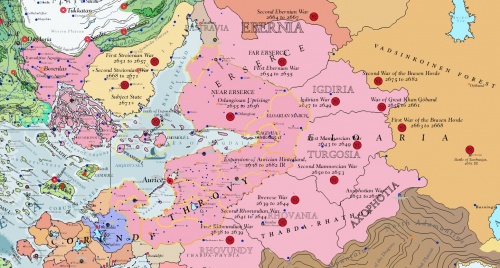Expansion of Inland Aurician Empire in Late 2600's
Aurice made great territorial gains during the late 2600's (2638 to 2682). The Aurician Empire had leading edge titancraft technology and a highly organized and disciplined grand army, honed by decades of war against the Gorcorumbese Empire and previous conflicts against the Brasen Horde. This period of expansion was unique. Historically, the rulers of Lucacia and Erserce generally defended themselves from the hordes of the steppes and and were hesitant to invade its vast expanse even if part of a strategy of defense. The Aurician Empire was different from previous powers and made use of its superior military, strategy, and weaponry intentionally to subdue the tribes of the steppes over the forty four years of 2638 to 2682, incorporating Rhovundy, Rhovania, Axophotia, Turgosia, Igdiria, and half of Ebernia or the historical north territory of Erserce. The Shakhumbla of the Brasen Horde was obliged to make treaties with Aurice after several defeats. Streionia was defeated in the Second Streionian War (2668 to 2671) and became a dependency under joint rule of Aurice and Pytharnia as dictated in the terms of the Peace of Amyrn (2671). Pastravia, amid internal turmoil and failure to produce a ducal ruler, was annexed in 2711, becoming a subordinate province in the Aurician Over-province of Erserce.

Aurice largely avoided involvement in the conflict of the Sewdhaine War and focused its military resources on maintaining its colonial empire abroad and expanding into its hinterland to the east. Aurice also avoided engaging the warriors of the steppes in the treacherous Vadsinkoinen Forest. Despite these precautions, Aurice was engaged in as many as five different regional conflicts at a single time (2655) on the steppes during this period for a total of about fifteen wars and conflicts. The idea that Aurice was compelled to subdue the steppes to ensure its future peace became prevalent in the minds of the Senate and the people of Lucacia. In contrast, the Brasen Horde and the other tribes of the steppes wanted to conquer Lucacia, Erserce, and Aurice and establish the universal rule of the Shakhumbla throughout Asdauria. This conflict of ideology reached a peak and conclusion in the Second War of the Brasen Horde (2675 to 2682) at the Battle of Tarobunjat (2681).
Mineral wealth from Skaligdæ and Bijälenland paid for much of the Aurician war debt. The promised revenues of the Grand Shadew Canal covered the gap. Additionally, Aurice employed the customs of the steppes whereby the defeated become the military vassals of the victor. Rhovundian, Rhovanian, Turgosian Centaurs, Axophotian, and Ersercese soldiers gradually became auxiliaries in the Aurician Grand Army. Tribes were given great autonomy within their respective dominions. Individuals did not have to pay taxes to Aurice, but to the tribal ruler who in turn was required to make a nominal tribute to Aurice. They were principally required to give military service to Aurice.
Aurician military used a combination of dwarvenfire, titancraft, and mage-shielded dwarvenfire weaponry against the bisontaurs, centaurs, and Ersercese rebels. These nomadic and semi-nomadic peoples employed traditional weapons with great skill, but their lack of sustained agriculture meant they could not develop a sufficient population base and troops to defend themselves from Aurician expansion.
Technology
The Aurician Empire developed dragonrail transportation through its inland empire enabling it to move troops and materiel quickly. Titan-arms also played an important role, employed by elite troops of the Aurician Grand Army.
Chronology
- First Rhovundian War (2638 to 2639)
- Ibrevese War (2639 to 2644)
- Second Rhovundian War (2641 to 2644)
- First Mamnorcian War (2643 to 2649)
- Igdirian War (2647 to 2649)
- Second Mamnorcian War (2650 to 2653)
- First Streionian War (2651 to 2657)
- Axophotian War (2652 to 2658)
- War of the Shakhumbla Göband (2654 to 2661)
- First Ebernian War (2654 to 2655)
- Orlangissan Uprising (2655 to 2656)
- 2657: Uhlaks begin use of the tsagar, a heavy dwarvenfire rifle
- First War of the Brasen Horde (2663 to 2668)
- Second Ebernian War (2664 to 2667)
- Second Streionian War (2668 to 2671)
- Second War of the Brasen Horde (2675 to 2682)
Compare
- Shadevan Troll Uprising of 2670s
- Shadevan War, 2589 to 2591
- Skaligdæse War, 2576 to 2586
- Thykomian Revolt, 2668
- Bijälenlander Uprising, 2691 to 2694
See Also
- Annexation of the Shadevan
- Aurician Empire
- Battle of Kadraskan, 2634
- Battle of Tarobunjat (2681)
- Brasen Horde
- Grand Duke Vast Bijäl
- Shakhumbla Göband
- History of Dragonrail
- List of the Lords Governor-General of Aurice
- Sewdhaine War
- Shadevan War, 2589 to 2591
- Thykomian Revolt, 2668
| This article is a stub. It requires further development by the creator. |